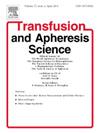Sex discrepancies in blood donation: Implications for red blood cell characteristics and transfusion efficacy
IF 1.4
4区 医学
Q4 HEMATOLOGY
引用次数: 0
Abstract
Red blood cell (RBC) transfusions carry risks, and the mechanisms mediating adverse transfusion outcomes are not fully understood. This review explores the impact of donor sex and donor-recipient sex mismatch on RBC characteristics and transfusion outcomes. Females, at least those in their reproductive age, have a higher proportion of young RBCs in the circulation when compared to males, associated with higher post transfusion recovery. Also, female RBCs exhibit a greater resilience to the storage lesion, with lower hemolysis rates and better rheologic properties. Despite these qualities, transfusion of female RBCs may be associated with adverse transfusion outcomes, such as pulmonary injury, increased mortality, and immunomodulatory effects, which may differ depending on the sex of the recipient, although not all observations are consistent. As a potential mechanism, the presence of immature RBCs, especially reticulocytes, in transfused blood is associated with immunomodulatory effects. Reticulocytes contain residual cellular components which can interact with surrounding blood cells and endothelial cells, in particular in neonates and cancer patients. Understanding the influence of donor sex and RBC age-subpopulation on RBC quality, and investigating the risks and benefits of immature RBCs in transfusions, offers opportunities for optimizing transfusion practices.
献血中的性别差异:对红细胞特性和输血效果的影响
输注红细胞(RBC)存在风险,而导致不良输血结果的机制尚未完全明了。本综述探讨了献血者性别和献血者与受血者性别不匹配对红细胞特性和输血结果的影响。与男性相比,女性(至少是处于生育年龄的女性)血液循环中年轻 RBC 的比例较高,这与较高的输血后恢复率有关。此外,女性红细胞对储存病变有更强的抵抗力,溶血率更低,流变学特性更好。尽管雌性红细胞具有这些特性,但输注雌性红细胞可能会导致不良输血结果,如肺部损伤、死亡率升高和免疫调节作用,这可能因受血者的性别而异,但并非所有观察结果都一致。作为一种潜在的机制,输血血液中存在未成熟的红细胞,尤其是网织红细胞,与免疫调节作用有关。网织红细胞含有残留的细胞成分,可与周围的血细胞和内皮细胞相互作用,尤其是在新生儿和癌症患者中。了解捐献者性别和网织红细胞年龄亚群对网织红细胞质量的影响,并调查输血中未成熟网织红细胞的风险和益处,为优化输血操作提供了机会。
本文章由计算机程序翻译,如有差异,请以英文原文为准。
求助全文
约1分钟内获得全文
求助全文
来源期刊
CiteScore
3.60
自引率
5.30%
发文量
181
审稿时长
42 days
期刊介绍:
Transfusion and Apheresis Science brings comprehensive and up-to-date information to physicians and health care professionals involved in the rapidly changing fields of transfusion medicine, hemostasis and apheresis. The journal presents original articles relating to scientific and clinical studies in the areas of immunohematology, transfusion practice, bleeding and thrombotic disorders and both therapeutic and donor apheresis including hematopoietic stem cells. Topics covered include the collection and processing of blood, compatibility testing and guidelines for the use of blood products, as well as screening for and transmission of blood-borne diseases. All areas of apheresis - therapeutic and collection - are also addressed. We would like to specifically encourage allied health professionals in this area to submit manuscripts that relate to improved patient and donor care, technical aspects and educational issues.
Transfusion and Apheresis Science features a "Theme" section which includes, in each issue, a group of papers designed to review a specific topic of current importance in transfusion and hemostasis for the discussion of topical issues specific to apheresis and focuses on the operators'' viewpoint. Another section is "What''s Happening" which provides informal reporting of activities in the field. In addition, brief case reports and Letters to the Editor, as well as reviews of meetings and events of general interest, and a listing of recent patents make the journal a complete source of information for practitioners of transfusion, hemostasis and apheresis science. Immediate dissemination of important information is ensured by the commitment of Transfusion and Apheresis Science to rapid publication of both symposia and submitted papers.

 求助内容:
求助内容: 应助结果提醒方式:
应助结果提醒方式:


